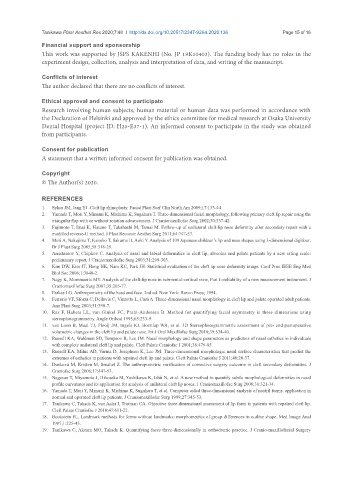Page 561 - Read Online
P. 561
Tanikawa Plast Aesthet Res 2020;7:48 I http://dx.doi.org/10.20517/2347-9264.2020.136 Page 15 of 16
Financial support and sponsorship
This work was supported by JSPS KAKENHI (No. JP 19K10403). The funding body has no roles in the
experiment design, collection, analysis and interpretation of data, and writing of the manuscript.
Conflicts of interest
The author declared that there are no conflicts of interest.
Ethical approval and consent to participate
Research involving human subjects, human material or human data was performed in accordance with
the Declaration of Helsinki and approved by the ethics committee for medical research at Osaka University
Dental Hospital (project ID: H25-E37-1). An informed consent to participate in the study was obtained
from participants.
Consent for publication
A statement that a written informed consent for publication was obtained.
Copyright
© The Author(s) 2020.
REFERENCES
1. Sykes JM, Jang YJ. Cleft lip rhinoplasty. Facial Plast Surf Clin North Am 2009;17:133-44.
2. Yamada T, Mori Y, Minami K, Mishima K, Sugahara T. Three-dimensional facial morphology, following primary cleft lip repair using the
triangular flap with or without rotation advancement. J Craniomaxillofac Surg 2002;30:337-42.
3. Fujimoto T, Imai K, Hatano T, Takahashi M, Tamai M. Follow-up of unilateral cleft-lip nose deformity after secondary repair with a
modified reverse-U method. J Plast Reconstr Aesthet Surg 2011;64:747-53.
4. Mori A, Nakajima T, Kaneko T, Sakuma H, Aoki Y. Analysis of 109 Japanese children’s lip and nose shapes using 3-dimensional digitizer.
Br J Plast Surg 2005;58:318-29.
5. Anastassov Y, Chipkov C. Analysis of nasal and labial deformities in cleft lip, alveolus and palate patients by a new rating scale:
preliminary report. J Craniomaxillofac Surg 2003;31:299-303.
6. Kim DW, Kim JT, Hong HK, Nam KC, Park JH. Statistical evaluation of the cleft lip nose deformity image. Conf Proc IEEE Eng Med
Biol Soc 2006;1:3840-2.
7. Nagy K, Mommaerts MY. Analysis of the cleft-lip nose in submental-vertical view, Part I--reliability of a new measurement instrument. J
Craniomaxillofac Surg 2007;35:265-77.
8. Farkas LG. Anthropometry of the head and face. 2nd ed. New York: Raven Press; 1994.
9. Ferrario VF, Sforza C, Dellavia C, Vizzotto L, Carù A. Three-dimensional nasal morphology in cleft lip and palate operated adult patients.
Ann Plast Surg 2003;51:390-7.
10. Ras F, Habets LL, van Ginkel FC, Prahl-Andersen B. Method for quantifying facial asymmetry in three dimensions using
stereophotogrammetry. Angle Orthod 1995;65:233-9.
11. van Loon B, Maal TJ, Plooij JM, Ingels KJ, Borstlap WA, et al. 3D Stereophotogrammetric assessment of pre- and postoperative
volumetric changes in the cleft lip and palate nose. Int J Oral Maxillofac Surg 2010;39:534-40.
12. Russell KA, Waldman SD, Tompson B, Lee JM. Nasal morphology and shape parameters as predictors of nasal esthetics in individuals
with complete unilateral cleft lip and palate. Cleft Palate Craniofac J 2001;38:476-85.
13. Russell KA, Milne AD, Varma D, Josephson K, Lee JM. Three-dimensional morphologic nasal surface characteristics that predict the
extremes of esthetics in patients with repaired cleft lip and palate. Cleft Palate Craniofac J 2011;48:28-37.
14. Dusková M, Kristen M, Smahel Z. The anthropometric verification of corrective surgery outcome in cleft secondary deformities. J
Craniofac Surg 2006;17:447-53.
15. Nagasao T, Miyamoto J, Hikosaka M, Yoshikawa K, Ishii N, et al. A new method to quantify subtle morphological deformities in nasal
profile curvatures and its application for analysis of unilateral cleft lip noses. J Craniomaxillofac Surg 2008;36:321-34.
16. Yamada T, Mori Y, Minami K, Mishima K, Sugahara T, et al. Computer aided three-dimensional analysis of nostril forms: application in
normal and operated cleft lip patients. J Craniomaxillofac Surg 1999;27:345-53.
17. Tanikawa C, Takada K, van Aalst J, Trotman CA. Objective three-dimensional assessment of lip form in patients with repaired cleft lip.
Cleft Palate Craniofac J 2010;47:611-22.
18. Bookstein FL. Landmark methods for forms without landmarks: morphometrics of group differences in outline shape. Med Image Anal
1997;1:225-43.
19. Tanikawa C, Akcam MO, Takada K. Quantifying faces three-dimensionally in orthodontic practice. J Cranio-maxillofacial Surgery

